Find the best perch lures & rigs
Let’s start by looking at the four perch lures that will cover you in every fishing situation. Then, let’s break down every perch lure, jig and rig by type. Finally, we’ll highlight some of the best rigs that are used on the predator competition circuit.
This page contains product recommendations to Amazon from which fishmag earns a commission.

Summer vs winter perch lures
A quick note – in winter, perch have slower metabolisms. This means they need to eat less food. From November onwards perch are looking for meals that require minimal effort and energy expenditure. This means fishing with smaller lures, retrieving more slowly and fishing closer to the bottom. For instance, a straight-tailed lure on a jig head or a 3″ soft plastic on a drop shot rig would be good options.
Summer perch fishing in the UK more often means reaching for the larger paddle tails and plugs with more significant actions. These will draw attention to the lure when there is high food availability and the fish are up for a chase. Every lure can work at any time of year, but summer is generally the best time for fishing those larger crank baits and spinners fast through the mid and upper sections of the water.
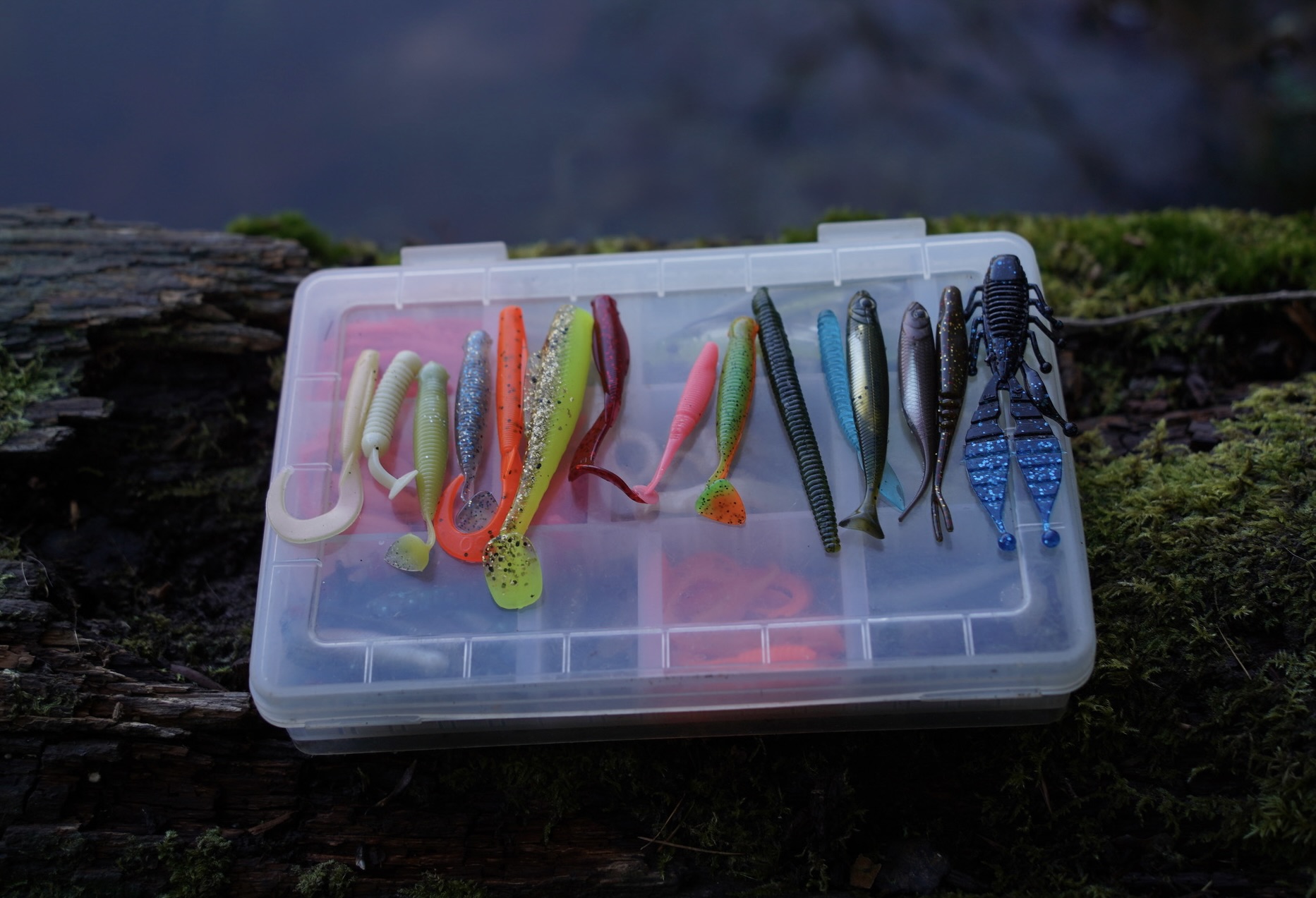
In colder water, fish smaller, slower, deeper. In warmer water, you can fish bigger lures faster and need to seek out fish in the whole water. That’s because in summer perch are more spread out. In winter they move into deeper areas and shoal more tightly. Dusk and dawn are best by far as is water with a little bit of colour, but not too much. In murky water, fish bigger, flashier, slower and closer to known fish-holding structures.
When water is clear, fish deeper and in the shade. Perch don’t like bright conditions. If you’re fishing a popular fishing spot, fish smaller with a finesse approach as fish may be more cautious. Use light-coloured lures if the bottom is dark and leafy, for colour contrast. Use dark-coloured lures if the bed is silty and light. If pike are present, use a 15lb wire trace. If you have a boat, get a fish finder.
Now let’s jump into the lures. Then we’ll look at the rigs you can make up with them.
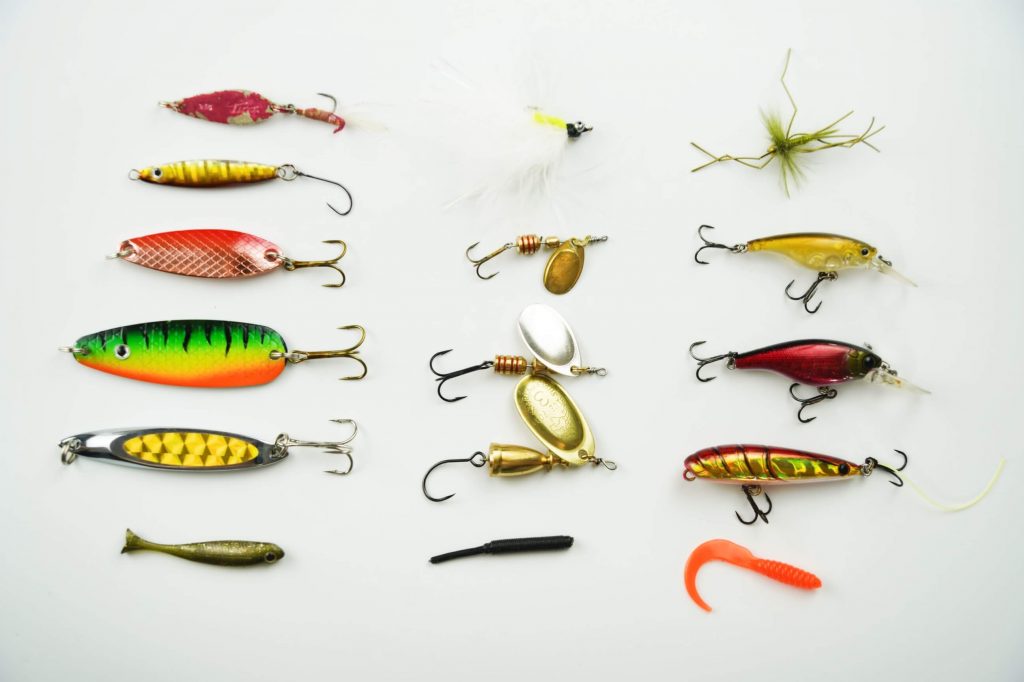
Soft plastic lures for perch
Jig heads and soft plastics for perch
Jig heads between 1-10g are effective for perch fishing and allow you to experiment with lots of different soft plastic styles, actions and colours. This rig also gives you direct contact with the lure, so bites are easily registered in the rod. Jig heads larger than 10g are likely to spook fish, especially in winter.
TT Lures Headlockz Finesse – view on Veals
Fox Rage Micro Jigs – view on Amazon
This block contains unexpected or invalid content.
Attempt Block Recovery
Paddle tails for perch
This is one of the more favoured lures of choice for targeting perch. There’s hundreds of different paddle tails to chose from, with vastly different profiles and colours, and it’s easy to see why. Most predatory species will hit a paddle tail. Out of all the soft lures paddle tails provide the most action, so can work extremely well when fish are feeding aggressively. A paddle tail between 2″ and 4″ is generally used, although if you want to target specimen perch sometimes a larger 5″ lure can work.
Fiiish Minnow 70 – view on Veals
Minnow Imitations – view on Amazon
Lunker City 4″ Swimming Ribster – view on Veals
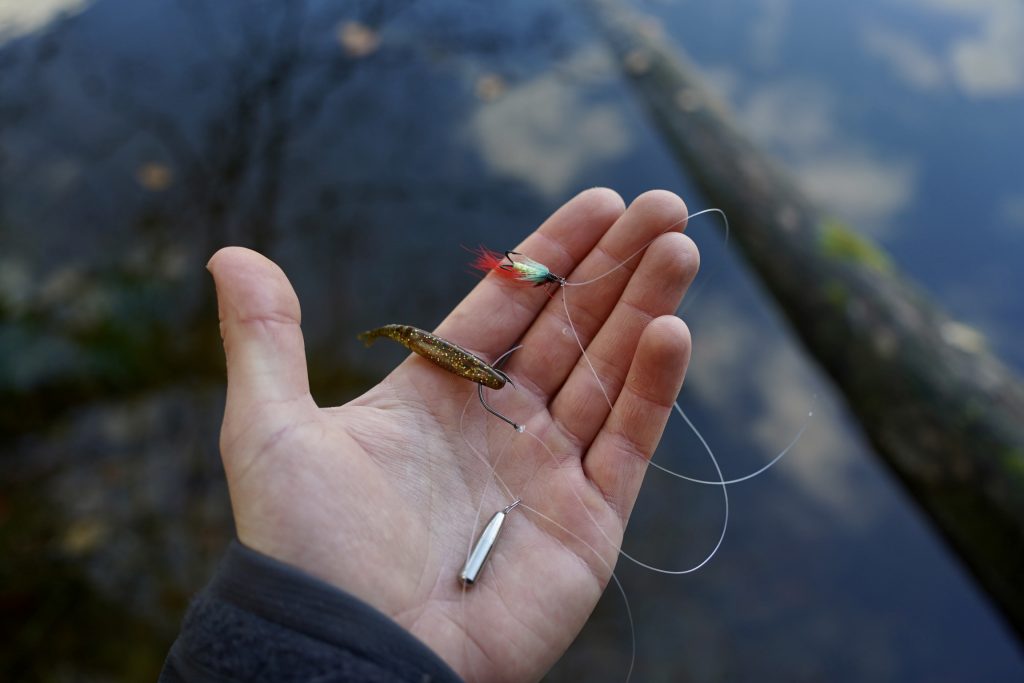
Straight tails for perch
These have boomed in popularity in the last 10 years or so. Anglers have learnt that sometimes a lure can have too much action. These lures generally work best when the fish are feeding more cautiously, or in the winter, when their metabolisms have slowed. 2″-4.5″ lures seem to work the best, with the larger lures better for the bigger perch. Some of the straight lures have ribbed bodies that add subtle vibrations to the water. These usually fish better on a slower retrieve, especially hopping the lure slowly along the bottom.
HTO Schlugg 4.5″ – View on Veals
Lunker City 4.5″ Ribster – View on Veals
Z-Man Finesse TRD – View on Veals
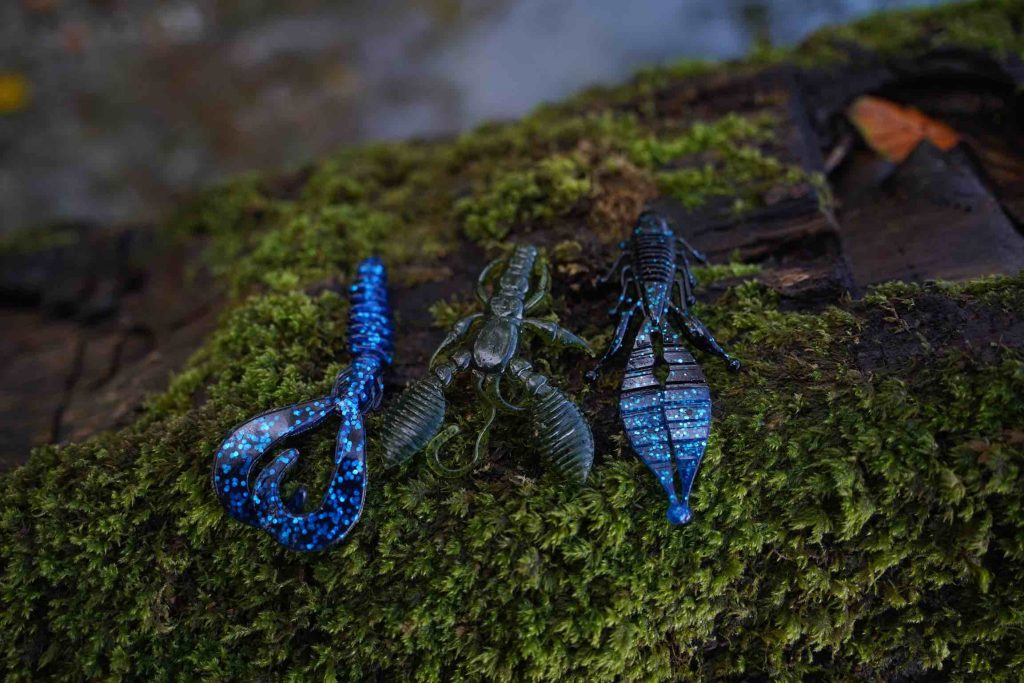
Creature baits for perch
There are a lot of creature baits on the UK market, but very few species that like to strike them. Perch are one of the species that love hitting creature baits because they imitate perfectly the young freshwater crayfish we have in British waters. Naturally, these lures should always be fished on or close to the bottom, which means a weedless rig like the texas rig is usually the best.
Z-Man Punch Crawz – view on Veals
Crayfish Imitation – view on Amazon
Z-Man Crusteaz – view on Veals
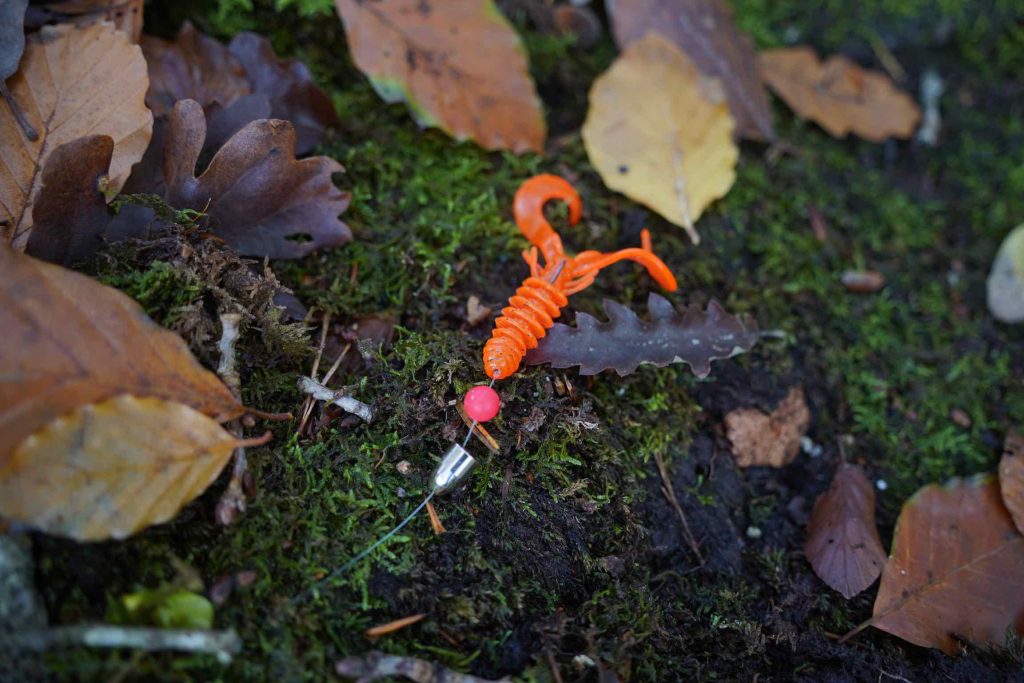
Curly tails for perch
Curly tails work great with perch. Back when it was available in the UK, the Ecogear Paramax was considered one of the top perch lures you could buy. The colour orange was extremely popular. For lure fishing in the UK more generally, curly tails are not as great as paddle tails because they seem to elicit more tail-nips – bites on the tail of the lure that don’t result in hookups. This is not such a problem with the perch, because they inhale lures rather than nip at them.
Fish seem to either freak out in response to curly tails thinking ‘what the heck is that alien doing on my water’ OR they smash them to bits. Perch are a species that typically take the latter approach.
Z-Man Grubz 2.5″ – view on Veals
Savage Gear Pro Grub Set – view on Amazon
Perch spinners
The Mepps Spinner was designed by a French company several decades ago and is now perhaps the most iconic lure ever made. It’s irresistible simplicity and consistent performance has made it a staple for many, and these spinners are available at relatively cheap price in every size you might need. Spinners are especially good for anglers that are using perch lure rods that are slightly heavier – capable of casting over 20g. Many UK anglers use rods that cast 30-50g for perch, which is handy if you’re expecting to hook big pike, too. On a rod like this, most of the lures in this article would be too light for you to cast, but you can find spinners that are perfect with a rod like that. You will be forced to fish with slightly bigger lures and filter out smaller fish but if you’re fishing that heavy you’re not bothered about that anyway.
Mepps spinners for perch
This block contains unexpected or invalid content.
Attempt Block Recovery
Spinners are not nearly as popular as they used to be with the likes of pre-made weedless lures like the Fiish Minnow, but they are cost-effective and do still work.
Smaller mepps spinners can also work great on ultra-light outfits. These spinner range in size of 00 to size 5. The Aglia is the most famous of their spinner designs. The lures are available in a huge range of colours and it pays to have a selection so you can switch things up on the day if the fish get wise / turned off to a particular colour you’ve been casting for a while. Some of these spinners have cone-style weights and others have a different style – I don’t think it matters, as long as the weight is matched with the casting weight of your rod (at least 50% of your rod’s casting weight ideally) and the hook size is appropriate.
Mepps spinners can work all year round for perch. In winter you will need to fish deeper and slower and in summer faster and throughout the whole water column. Fishing these lures quickly in summer to elicit powerful strikes from fish is one of the most rewarding ways of targeting perch because they hit you like a steam train.
What size spinner for perch?
In the Mepps Aglia sizes, #0 = 2.3g, #1 = 3.1g, #2 = 4.7g, #3 = 7g, #4 = 9.4g, #5 = 15g. Size 3g is great with a lightweight outfit, size 5 for anglers not using a regular light spinning rod that isn’t a specialist ultralight outfit.
Perch plugs
When it comes to perch plugs, crankbaits with short, fat bodies that actually mimic that of the perch themselves are more popular than minnow-style lures with elongated bodies. I suppose the profile of rudd or young perch is rounded rather than long and thin, so perhaps this explains the apparent preference.
Best size plugs for perch
Perch plugs should be 2-3”, 6-10cm. There’s no need to go larger than this and you will likely begin spooking many fish if you do.
The length of the bib on the front of the lure indicates how deep it will dive, and you might like to have a mixture of shallow divers and sinking lures. Note that plugs are far more prone to snags than any other lure type due to their treble hooks protruding on the bottom of the lure, so they are best for areas with cleaner bottoms in general.
Crankbaits for perch
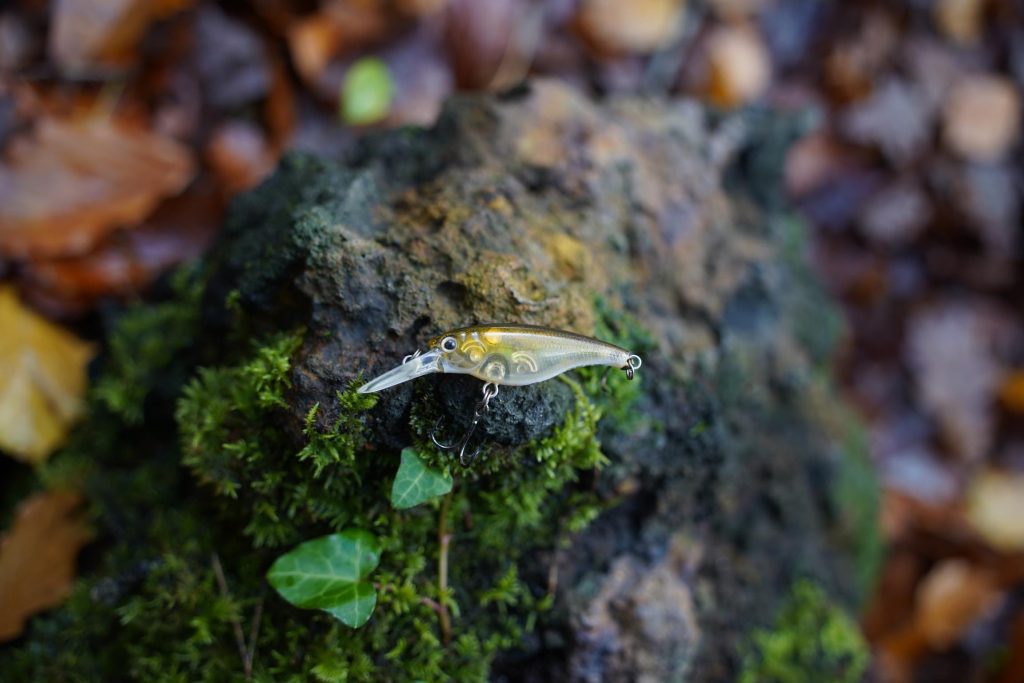
Crankbaits/plugs can be used to work an area very quickly. They are useful for eliciting impulse responses from fish since the Perch have limited time to make a decision before hitting a lure that whizzes past them. They should be cast to the edges of riverbanks, into promising deeper pockets and right at your feet on canals. It’s useful to cast in a ‘fan’ shape to cover a whole area before moving on to cover more ground, actively seeking out the fish. Plugs are an efficient way of doing this.
Plugs are best used in summer when fish are feeding more aggressively and are spread further apart chasing baitfish, rather than just holding to structures and the bottom like they do in winter. The vibrations imparted by crankbaits can be detected by perch that cannot even see the lure, but those same vibrations can freak fish out if they’re not in the mood. Perch are prey for larger species like pike, as well as predators themselves.
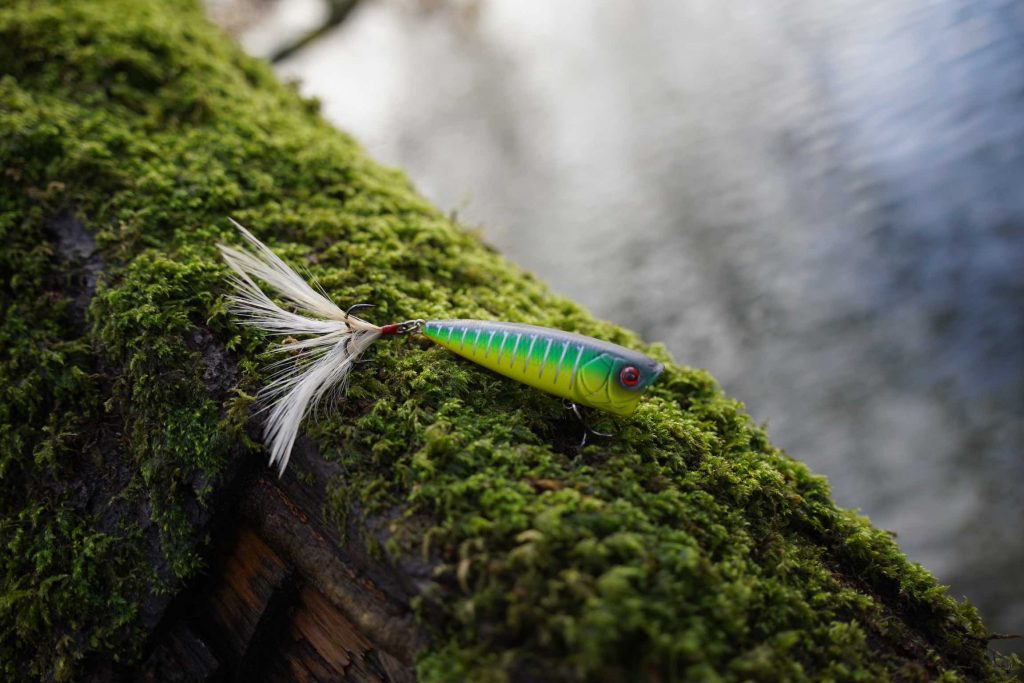
Surface Lures & Perch Poppers!?
Fishing for perch on the surface is a method that is pretty much unheard of in the UK, and we don’t think it’s very effective in the UK compared to other methods on this page. I have landed a perch before that was caught out of the water – I suspended a lure just out of the water in an area where a stream enters a pond. The water was crystal clear and you could see the perch lingering around this area. The fish leapt from the water to take the lure out of the air.
Fishing with poppers for perch is exciting and worth it if you know what you’re doing. If you’re going to try it, reach for very small lures – around 1” long. About twice the length of the nail on your thumb. I would experiment with a fly fishing popper. Expect more interest from pike and trout if they are present!
If you have experience surface fishing for perch, drop me a message, I’d like to hear about it. [email protected]
Alternative perch lures
The two most notable alternative perch lures are frog lures and worm imitations like Marukyu Isome or gulp worms
Frog imitations?!
The first of these, frog imitations, are usually purchased by beginner anglers as part of a low-cost fishing kit box which would have been designed for US freshwater bass anglers but is being sold in the UK. They are not effective for Perch.
Worm imitations – the best perch bait
What is the best perch bait? It’s a lobworm. So, in our lure fishing kit, it’s handy to have some worm imitations.
Marukyu Isome or gulp worms are certainly effective for Perch in the winter months when fished very passively on or near the bottom. This is as close to bait fishing as you can get and is ideal when perch are super lazy.
Flies
Perch are caught by fly anglers as bycatch when targeting trout. Flies work, especially when they are slowly sinking towards the bottom. Fishing for them with a spinning rod is not particularly practical, but certainly can be done with a bombarda rig or with a drop shot rig.
Perch rigs
Perch inhale lures. If your line is tight, your lure may not be sucked up by the perch in the way the perch expects. This is one reason some advanced lure anglers actually go back to using mono instead of braid for certain situations. Rigs like the Carolina rig and drop shot can make it possible to fish with an ever so slightly slack line. This is generally not necessary but if fish are incredibly spooky it can pay to slacken your line just a little bit. You can still notice bites – you see them in the line as it moves rather than in the rod tip.
Jig heads for perch fishing
Perch fishing requires experimentation with soft plastic size, action and colour and jig heads allow you to quickly change your lure without retying lures. Jig heads are hooks that have weights built into them, which can appear as circular balls around the eye of the hook or can be in the shape of the head of a fish for a more realistic presentation. They come with straight hooks or weedless hooks. If you’re fishing ultra-light with very fine jig heads, you need to set your drag so larger fish can’t bend the hook out.
This block contains unexpected or invalid content.
Attempt Block Recovery
Best size jig heads for perch
For the smallest perch, size 8 jig heads are perfect. You don’t need to use hooks larger than size 1/0 for any perch. Weight ranges between 3-10g are useful.
Buy jig heads between size 6 – 1/0 and soft plastics between 1-3” in length. Use larger hook sizes to filter out smaller perch.
For beginners and people that don’t have time on their hands, buy pre-rigged jig heads and soft lures so you don’t have to think about it and you know they work well together.
A common mistake is fishing too erratically and freaking fish out, or fishing too close to the surface because the lure hasn’t had time to fall.
Types of jig head for perch fishing
There are a few types of jig heads that can be used for perch fishing. The most common and cheapest jig heads have ‘ball heads’ – essentially round ball. These are great for bumping along the bottom. Then you have dart jig heads and finesse jig heads, which are both designed to move side to side when twitched to imitate an injured fish. These work well with straight tail lures that have limited actions without a dart jig head. There are also level swim heads, which are designed to fall parallel to the surface of the water (rather than nose dive like most jig heads). These often have a cylinder, or bullet shape, similar to the weight on a drop shot rig. There are weedless jig heads, which have weedless hooks to avoid snagging. These are useful for perch fishing anywhere with lots of snags, be they lily pads, reeds or submerged shopping trolleys.
Fish head style jig heads have the lead weight shaped to imitate the head of a fish and look fantastic rigged on a variety of soft plastics. Often if a paddle tail has a head of its own, I will bite that off to replace it with the lead head on the jighead.
Neutral buoyancy jig heads are not made from lead but from resin. They cast well but unlike lead sink very slowly. These are useful for suspending lures in the very top section of the water. Useful for shallow water perch marks where you want to cast far yet fish slow and shallow.
Hidden weight jig heads have the weight on the shank of the hook. This means when you rig a soft plastic little or none of the weight is visible. These are useful for extremely cautious fish and might be useful for winter perch if you want a hyper-realistic presentation.
Bibbed jig heads have lips like plugs, and are designed to dive upon retrieval.
For perch fishing, this is an overwhelming selection – you just need to get some jig heads with weights below 10g and a range of hook sizes from size 6 to size 1 and you’re good to go.
Ned rig for perch
The Ned jig heads require their own section as they have become much more popular in recent years.
Ned rig jig heads have a short cylinder shape which is designed to make the lure stay vertical on the seabed rather than lie flat on the bottom. People use these with straight-tail lures like senkos or sluggos. This method is fished best with buoyant lures. The idea is that the lure presentation will be straighter, and the shape of the jig head provides excellent bottom sensitivity. It is usually fished slowly with long pauses, with the optional occasional hop along the bottom.
They have taken the US bass fishing world by storm and are equally effective for UK perch fishing with lures. It’s particularly popular in pressured waterways, as it offers an entirely new presentation to the fish. This is a rig that is sure to leave its mark in predator tournaments when targeting big perch with larger straight lures.
Texas Rig for UK Perch
The texas rig involves the use of a bullet weight, running freely on the line, directly above a weedless hook. You then thread the soft lure onto this weedless hook and you are good to go. It’s a very simple rig that is fast and easy to tie. This lure is fished on the bottom, so you cast it out and let it sink to the bottom, before bouncing it back, letting it sit for a while on the bottom, retrieving or lifting the lure and repeating. A simple cast and retrieve would also work. A common mistake is imparting too much action into the lure, especially in winter. A very slow retrieve (almost to the point that it’s like you’re bait fishing) is usually best in winter.
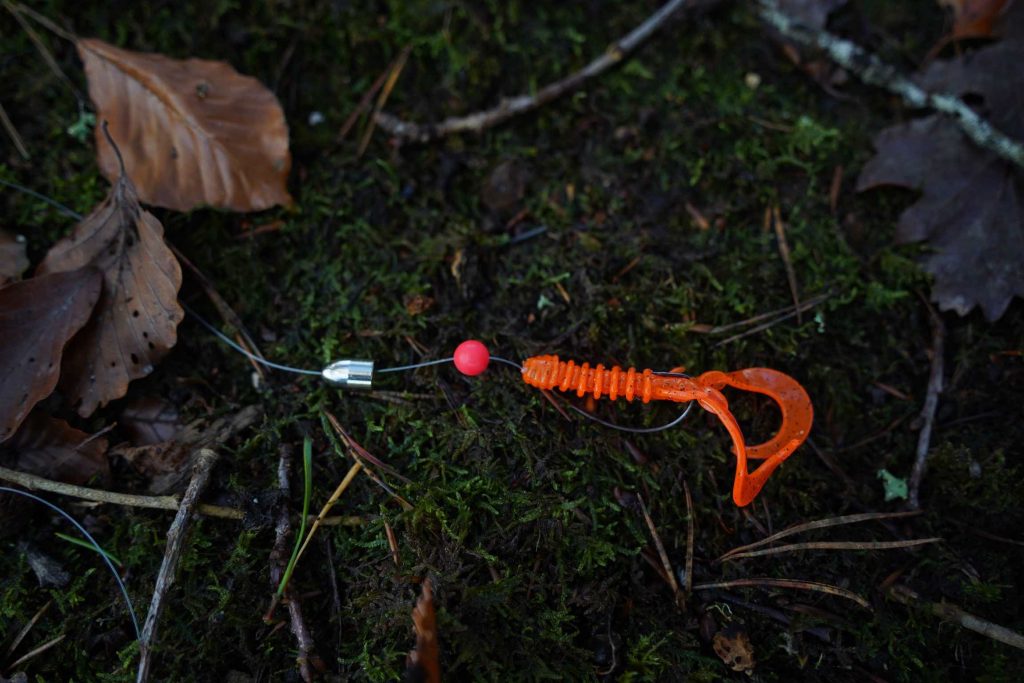
If you are fishing in a British pond, lake or canal in a city, there are lots of potential snags which just happen to be exactly the places the fish like to dwell – especially in winter. Shopping trolleys thrown into canals, car tyres, reed beds, water lilies – the list goes on. That’s where the perch will be, and the Texas rig lets you fish there.
The most commonly used soft plastics rigged on texas rigs are Senko’s and creature baits. Creature baits with floating claws can be great for perch and aid presentation, and Senkos are an example of a lure designed for US freshwater bass fishing that also works well for perch. Ultimately, any style of soft lure can be rigged on a texas rig but you should avoid soft plastics that have wide, thick profiles as that can reduce hook-up rates. If fish are striking tentatively, you can always reveal the hook point ever so slightly, and you will still have a fairly weedless lure just with slightly easier hookups.
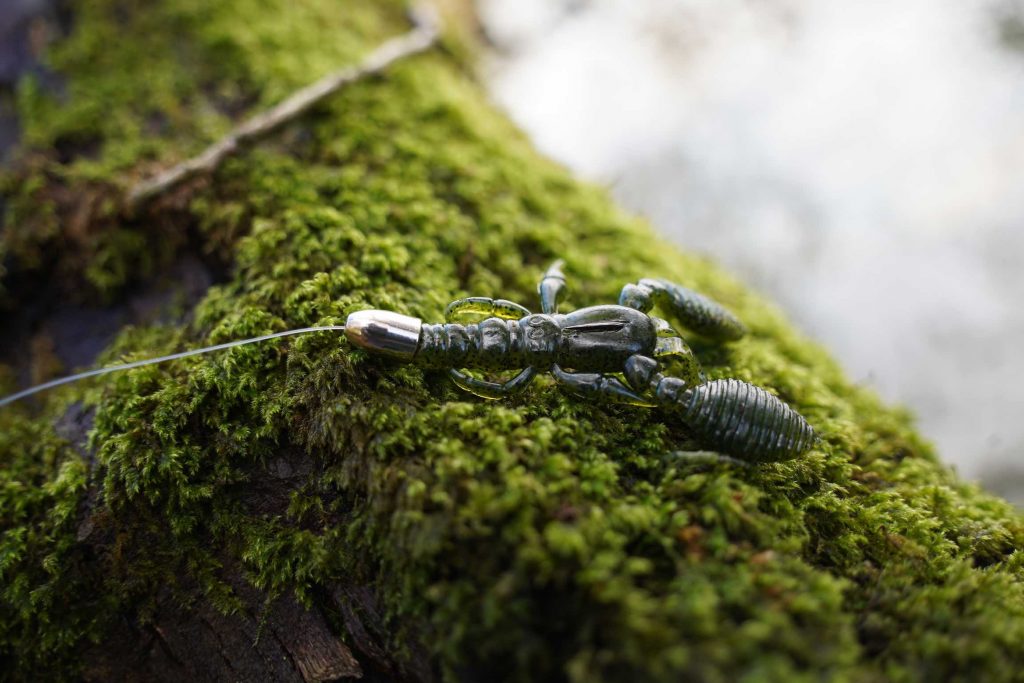
The main thing is to make sure you look at your rig in the water before fishing with it to make sure the weight and the soft lure and the hook are all sitting nicely in relation to each other. Sometimes you have to rig the lure again to make the lead and the soft plastic align straight with each other. The plastic between the hook point and the eye of your hook should not be pulled tight, nor should it bend from being too slack. The hook should poke through the soft lure exactly in the centre so the lure doesn’t swim sideways. The hook point should come out ⅓ to ½ way down the body of the lure. If it comes down too far, the lure doesn’t move. If it comes out too close to the top of the soft plastic you will get fewer hookups as fish bite the long tail of your lure and miss the hook.
Finally, it’s important that you rig the right size soft plastic on the right size lure. If you use a hook that’s too big it can ruin the action of the lure and if your hook is too small it can make hookups very difficult because not enough hook will appear when the fish bites. If the soft plastic is too long, you can just bite off the top part of the lure and make it shorter for a better presentation.
When fishing a texas rig it pays to use the lightest weight possible (that will still allow paddle tails to kick as they fall). If the weight is too heavy, the lure looks unnatural in the water and the action of the lure is suboptimal.
Carolina rig for perch
The Carolina rig features a bullet weight, then a float stop or swivel, then a section of leader about 1-2ft long, then a soft plastic rigged on a weedless hook. Unlike the texas rig, the weight and the hook are separate. This means you can fish with heavier bullet weights without interfering with the action or presentation of your soft plastic. A 15-30g bullet weight would ruin the presentation of soft plastics for perch if it was rigged right above the hook. With the Carolina rig, you can cast further and reach the bottom faster.
In the US bass scene from which this rig originates, they sometimes ‘peg’ the rig using a float stop to hold the bullet weight in place. This also means the weight can be skipped along the surface when using a baitcasting rod so you can cast under trees that an overhead cast would not allow you to reach.
Carolina vs Texas rig?
The Carolina rig provides a more natural presentation since the lure moves independently of the weight and sinks more slowly. However, you won’t feel bites as easily. When fish are cautious, this extra slack in your line can be an advantage. Generally, the texas rig is easier to fish, provides more bite sensitivity and is less prone to the leader getting tangled in your mainline upon casting.
Drop shot rig
The drop shot rig provides a natural lure presentation because the lure is not directly attached to the weight, and so is able to move in any current, sinking very slowly, when your line is slack. The lure is suspended just off the bottom, exactly in the sight line of bottom-dwelling fish. This is a great presentation. The drop shot itself – the weight – allows you to cast this lure a longer distance, and feel exactly what type of ground you’re fishing over since the weight provides a lot of sensitivity to the bottom.
The drop shot rig involves a 5ft fluorocarbon leader attached to your braid with a lead drop shot on the end. Attached to this fluorocarbon leader is a single hook, about halfway up the leader. Attached to this hook is your soft lure.
Drop shotting for perch
The drop shot rig is the best rig for perch fishing in the UK in the estimation of many experienced anglers. The rig casts well and allows you to suspend soft plastics just above the bottom in the line of sight of fish. The soft plastic can move independently of the weight when your line is slightly slack, allowing for a hyper-realistic presentation (because real dying fish don’t fall like a lead weight). Crucially the drop shot rig allows you to fish very slowly in the winter months, which appeals to lazy perch that don’t want to chase prey. It’s not a rig you retrieve quickly.
The typical drop shot rig involves a braided mainline attached to a 4ft fluorocarbon leader. At the bottom of this leader, a drop shot is attached – 5-10g. This is a lead weight in either a pencil shape or a pear shape. If it’s too round it will make your line tangle more. About halfway up the leader, a drop shot hook or regular hook is tied to the line. It’s very important you use the right type of knot to attach the hook to your leader otherwise you will create a weak point in the leader and the hook will sit in an awkward position on its side. The Palomar knot is great and very easy to learn.
Soft plastics are commonly just threaded through the head of the lure (not through the lure body), since this usually creates a better presentation and ensures the lure doesn’t sit parallel with the line but rather parallel with the surface of the water.
As with all your lures, test the action of the lure and rig in the shallows to see how it responds to different movements.
Deadsticking for perch
Deadsticking is when you cast out a lure and let it sit on the bottom doing nothing. Well, not exactly – if there is current your lure is probably still moving a little bit, but it doesn’t need to be. Perch in winter especially appreciate lures that don’t move. It’s hard to believe but if you’re fished for perch (or a number of other predators) you will know many hookups occur when you are doing absolutely nothing to your lure.
This method involves letting your lure sit on the bottom, then gently twitching up to make it visible to fish passing by and repeating all the way back in through your retrieve.
Cheb Rig (Cheburashka rig) for Perch
The Cheburashka rig is named after a creature from a Russian children’s book that was turned down by a zoo as an “animal unknown to science”. For anglers, it is a rig that allows you to fish just like you would with a regular jig head, except you can easily change the weight or hook size. This means you can fish small hooks with larger weights than you will find on jig heads. When fishing with an ultra-light set up, it’s often handy to be able to cast a smaller hook further with the use of the cheb rig.
For perch fishing, jig head hook and weight sizes are usually actually pretty good as they come – the advantage of this rig for perch is that the weight is not directly part of the hook, which means the soft plastic can hover just slightly above the bottom with a raised profile (ass up, if you know what I mean). This is hard to achieve with a regular jig head and makes your lure stand out more to fish. It gives your soft plastic the appearance of a fish feeding on the bottom itself – face in the mud. This is a hyperrealistic presentation.
In comparison with a texas rig, the Cheb rig gives you direct contact with weight and lure so bites are more decisively felt. In comparison with a jig head, you can change the weight and lure size more easily.
Jika rig for perch
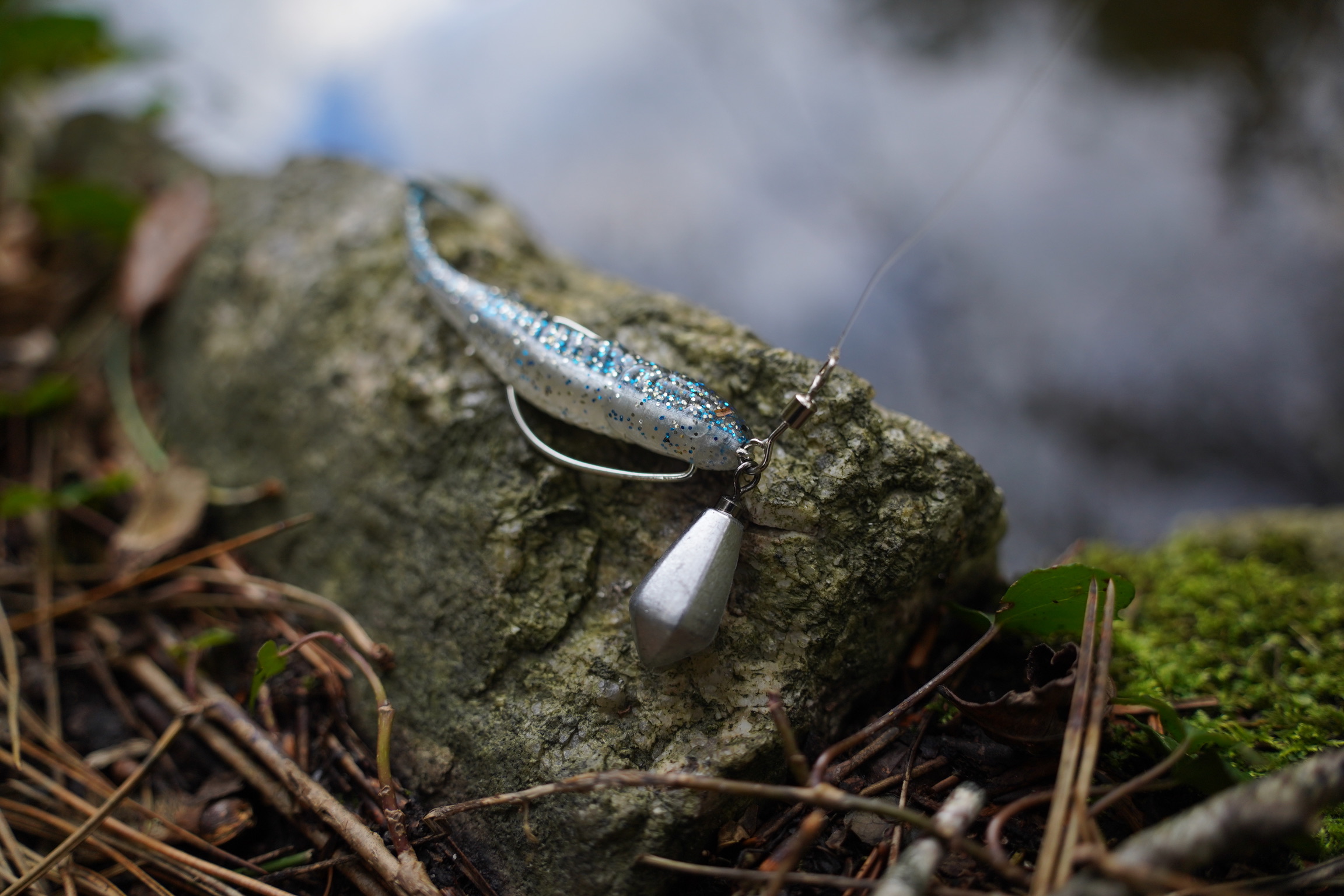
The Jika rig is a drop shot weight attached to a split ring with a weedless hook also attached to the split ring. It is like a cross between the texas rig and a jighead. You can quickly change the weight you’re fishing with. The Jika rig provides more sensitivity with the bottom than pretty much any other rig. Something about those drop-shot weights provides a lot of sensitivity. This is the main reason the rig is popular. Like the Cheb rig, the soft plastic can move more freely than it could if it had a weight directly attached to it. This creates a killer action as the lure is unencumbered by the weight. When fished OTD (on the drop) the lure falls vertically and freely which is a deadly action. They are fished on or close to the bottom in vegetated areas where weedless rigs are required. Perfect for winter perch fishing in the UK when fish stick around the structure and feed nearer the bottom.
The Jikka rig can be dragged along the bottom or ‘tapped’ along the bottom. Both will create noise that attracts fish and stir up the sediment on the bottom, another attractant that leaves a trail of suspended sediment perch will follow like a dust cloud.
Best Perch Lures Q&A
What’s the best colour lure for perch?
Generally, at fishmag, we advise caution when choosing lure colours designed for US bass anglers, because they often come in very bright, whacky colours that don’t reflect the colouration of fish in Europe. However, when it comes to perch, they do seem to respond well to the whackiest colours as well as more natural presentations, and FISHMAG doesn’t have a verdict on which colours are best.
Bear in mind that lure contrast is probably more important than lure colour. A black lure provides a more distinct silhouette under street lighting than a white lure and is also more visible in cloudy water. A white lure will reflect more colour in deeper water, since white is a reflection of all light wavelengths at once, it will emit light better than any other colour in deeper water. The colour red is not visible below 5m because the red light wavelengths don’t penetrate past that (that’s why in movies, blood should be shown as black in scenes where the unfortunate is submerged more than 5m below the surface).
What do perch eat?
Consider the colours of the things Perch eat. Silver bait fish with orange fins. Brown crayfish. Dull coloured fry with silver eyes. Pinky-brown worms.
Next, read our perch fishing guide
